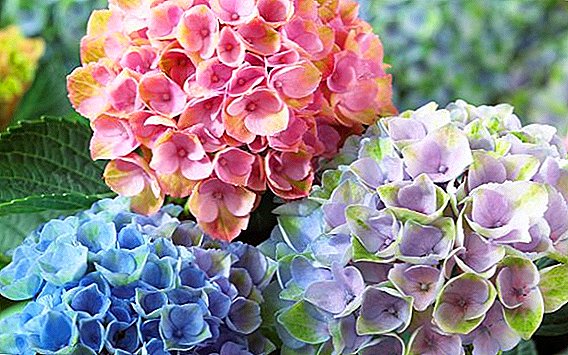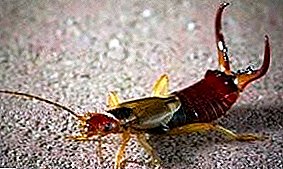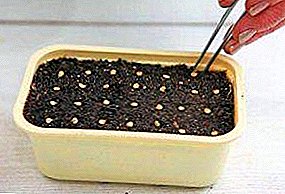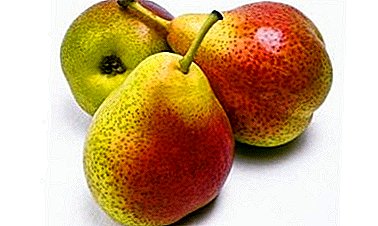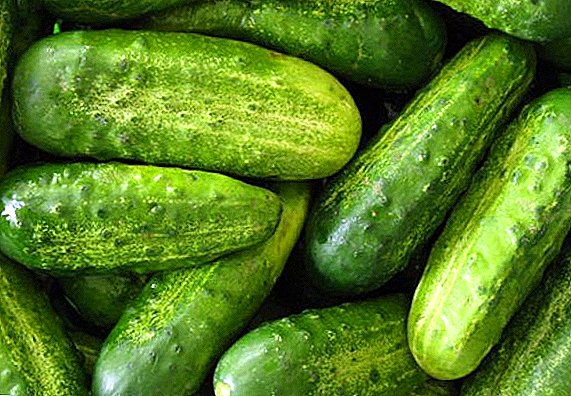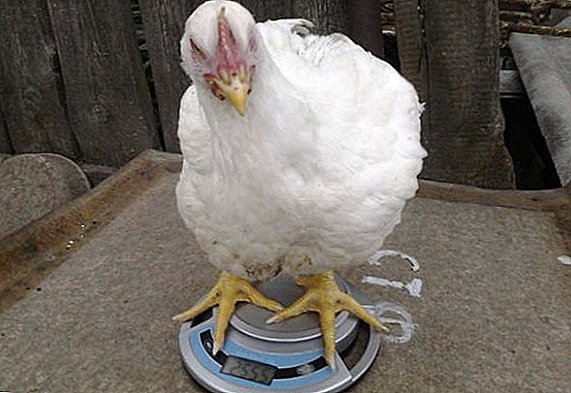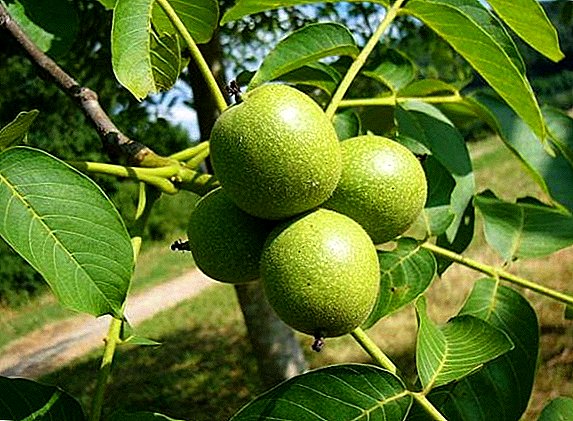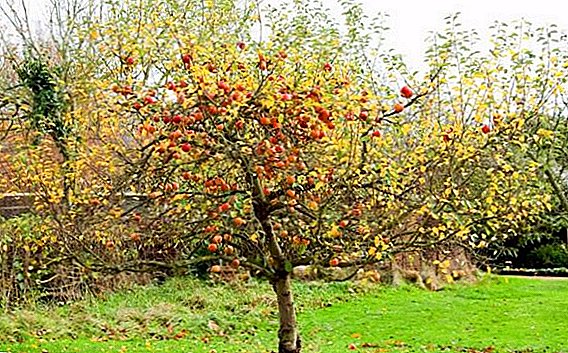 Often gardeners mistakenly believe that the best time to feed fruit trees and shrubs is spring, because the plants were exhausted in long winter and require a large amount of nutrients. In fact, it is not. In order to survive a long cold winter, our garden needs no less strength. Autumn top dressing is much more effective than spring, because depleted by fruiting plants are in dire need of nutrients. In addition, fertilizers increase the resistance of trees to diseases and provide a high yield in the next season.
Often gardeners mistakenly believe that the best time to feed fruit trees and shrubs is spring, because the plants were exhausted in long winter and require a large amount of nutrients. In fact, it is not. In order to survive a long cold winter, our garden needs no less strength. Autumn top dressing is much more effective than spring, because depleted by fruiting plants are in dire need of nutrients. In addition, fertilizers increase the resistance of trees to diseases and provide a high yield in the next season.
When to feed the trees and shrubs in autumn
Autumn feeding of trees begins in August and lasts until the end of September / beginning of October. It is during this period that the fruiting of shrubs and fruit trees ends, which allows starting work on preparing the garden for winter. 
Than to fertilize
It is possible to enrich the soil with nutrients using both mineral and organic fertilizers. How exactly to give preference depends on the composition of the soil and the desired results.
Mineral fertilizers
This type of dressing is: nitrogenous, phosphoric and potash. It is these three elements that play a leading role in the full development of plants.
Phosphoric fertilizers
Phosphorus is a substance that is hardly soluble in water. Fertilizer should be embedded deep into the ground in the field of suction root processes. Overdoing with phosphate rock is impossible, the plant will take as much as he needs. This type of feeding is responsible for the metabolic processes of the plant and is a necessary source of nutrition for fruit crops.
Basic phosphate fertilizers:
- superphosphate / double superphosphate;
- ammophos;
- diammophos;
- bone flour.

Potash
This dressing increases winter hardiness and endurance of trees and shrubs to drought. A lack of potassium leads to the formation of a weak plant stem. Light and peaty soils are most in need of this fertilizer, and heavy and clay soils hold potassium so well. Autumn is a rainy season, and these conditions are ideal for potash fertilizers, which are valid only with a sufficient level of humidity.
Most often, the following potash fertilizers are used in garden plots:
- potassium sulfate;
- potassium chloride;
- potassium salt;
- cement dust.

Combined
The difference between these fertilizers and other mineral supplements is that they consist of a combination of several nutrients. Depending on the components may be:
- nitrogen-phosphoric;
- nitrogen-phosphorus-potassium.
This type of fertilizer includes:
- nitrophoska;
- nitroammophoska;
- ammonium and potassium polyphosphates.
Important! Nitrogen fertilizers contribute to the development of green mass of the plant, so it is not recommended to make them in the fall. This can trigger the growth of a fruit tree or shrub, which is absolutely undesirable in winter..

Organic
Compared to mineral, this type of fertilizer is more available. And many people abuse it, fertilize it in amounts that significantly exceed the norm. It turns out that the introduction of natural products also requires certain rules.
Manure and droppings
In order for manure to be ready for use, it must be at least four months apart. It is best to apply dressing sustained for two to three years. The reason to refuse to apply fresh fertilizer is the high content of weed seeds and pathogenic bacteria in it. Manure is applied when digging in natural form at the rate of 8 kilograms per square meter or in the form of a solution for irrigation, which is prepared from 10 liters of water and 3 kilograms of manure.
Learn more about the properties of cow, pig, sheep, horse, rabbit manure and slurry.Litter - a very valuable organic fertilizer. The most effective is pigeon and chicken, in duck and goose the concentration of nutrients is much lower. Excessive use of this organic fertilizer can cause the accumulation of nitrates in plants. Fertilizer should be applied raw in the calculation: no more than 0.5 kg per square meter, dry - 0.2 kg.

Humus
One of the most valuable organic fertilizers. Humidity is called completely rotted manure, which turns into a loose mass, devoid of the smell of ammonia and rot. The peculiarity of this type of fertilizer is its versatility.
Humus is suitable for any type of soil: in sandy ones - it keeps nutrients in the root zone, in clayey - makes it more friable. The application of humus in the autumn is carried out after harvest at the rate of 6-8 kg of fertilizer per cubic meter.
Did you know? Human feces in Japan have long been considered good fertilizer, and the feces of the rich were valued much higher because of the varied diet of the nobility.

Peat and peat compost
Peat consists of remnants of marsh plants and animals that are compressed under natural conditions and, due to high humidity and lack of air, form a mass rich in nitrogen. Depending on the degree of decomposition of the organic components, peat can be upland, lowland and transitional.
Making pure peat ineffective, because the nitrogen contained in it has a positive effect on plants only after mineralization. In its natural form, peat has the ability to absorb moisture from the soil, which adversely affects the development of the plant. It is possible to mineralize peat, that is, to enrich the nitrogen contained in it with potassium and phosphorus, by adding manure.
Peaty compost It is prepared from one or two parts of peat and one part of manure, which are laid alternately in layers of 20-30 centimeters. To increase the potassium content in the mixture, you can add potassium salt to it. In dry weather, compost needs watering. The term of preparation of the finished fertilizer is three to four months. They make peat-oil compost when digging up soil at the rate of three to four kilograms per cubic meter. 
Compost
This fertilizer is prepared by their tops of cultivated plants and organic waste. For the mineralization of the substrate it is necessary not less than a year - during this period the humic substances will completely pass into the mineral forms necessary for the growth and fruiting of garden trees and shrubs.
Learn how to make a compost pit, organic waste compost, compost in bags.Autumn is the perfect time to feed this compost. During the winter, its final processing will take place, and in the spring a new fertile layer will be fully formed. They make compost in the same way as dung: 8 kilograms per square meter.

Biohumus
This top dressing is the result of the processing of organic agricultural wastes by earthworms and bacteria. Biohumus significantly improves soil structure. Its advantage over other organic fertilizers is that water-soluble forms of nitrogen, phosphorus and potassium in it are in high concentrations. This allows you to achieve an earlier ripening of fruits and berries (the crop can be harvested two weeks earlier than usual).
Learn what biohumus is, how to make it yourself, how to use it, and also how to breed rain and California worms.Together with biohumus, the soil receives important for the development of plants, earthworms and microorganisms, as well as their metabolic products. This allows you to significantly increase the yield of fruit trees and shrubs.
For garden fertilizer, biohumus is best used in liquid form, for this one part of the dry matter must be diluted in two parts of water.
Important! After applying dry fertilizer, the soil should be well moistened. The amount of water should be at least 10 liters per square meter.

Siderata
Siderata are annual plants that are planted in the soil in order to enrich its chemical composition and structure.
Dying off, siderats saturate the earth, increasing the activity of soil microorganisms and reducing its acidity.
This organic fertilizer can be applied to any type of soil. The most popular winter green manure crops are:
- rye;
- oats;
- rape;
- winter rape.
Find out how lupine, sweet clover, rape, buckwheat, rye, peas, phacelia, oats, mustard, and alfalfa are grown as a siderata.

Wood ash
Full vegetation of plants is impossible without many mineral compounds: calcium, potassium, zinc, sodium, boron and magnesium. With these substances, fruit trees and shrubs are able to saturate the burning products of dry plant waste, in other words, ordinary ash.
It improves plant immunity to diseases and pests, improves the quality of the soil, saturating it with mineral compounds. Ash is an effective fertilizer for fruit trees and shrubs, because it increases the acidity of the soil, which has a positive effect on its fruiting.
Learn how to use charcoal as a fertilizer.Autumn soil fertilization with ash should be carried out no more than once every three years. To deposit ash, it is necessary to dig a ditch 10 centimeters deep around the roots of fruit trees and shrubs, pour 100 g of ash into it and fill it with soil.

Sawdust
Sawdust used to loosen the soil. In no case it is impossible to feed wood waste in its pure form for feeding plants. It impoverishes the soil and binds a part of its useful elements.
To turn sawdust into fertilizer, you need to make them perepret. Under natural conditions, this process can take up to ten years. Therefore, on the basis of sawdust, by composting, it is possible to prepare a nitrogen-rich organic fertilizer.
To do this, sawdust folded in a pit or a pile, weeds, ash, urea and water are added to them. Compost can also be prepared using cow dung and humate. The finished fertilizer should resemble peat in appearance.
Sawdust also produces excellent mulch for fruit trees and shrubs. This cover is able to protect the root from freezing, and the plant - from death. A layer of sawdust laid in the fall around the root protects it from the cold without disturbing the air circulation. Another plus of mulching with sawdust is that weeds do not grow through them. 
Comprehensive feedings
Complex fertilizers include top dressing, which includes two or more batteries. The advantages of these supplements are that their rich composition makes it possible to almost completely satisfy the plant's need for nutrients at all stages of the growing season.
These fertilizers can be double or triple, as well as complex (several elements are included in a single chemical compound), mixed, which consist of a mixture of simple fertilizers, and complexly mixed, in which several chemical elements are contained in different chemical compounds.
The most common complex feeding:
- nitroammophoska;
- potassium nitrate;
- ammophos.

Features and norms of feeding
Among the huge variety of fertilizers for feeding fruit trees and shrubs, not all are suitable. Introducing top dressing, gardeners pursue certain goals - to increase the yield, prolong the fruiting period and increase the resistance to diseases and pests.
Fruit trees
Each type of fruit crops requires compliance with certain norms of fertilizing, which is introduced into the soil of the tree trunk to a depth of about two centimeters.
Peaches For feeding, a mixture of potassium salt and superphosphate in a ratio of 1: 2 is used.
Did you know? The soil in French vineyards is considered precious; workers must scrape it off the boot to bring it back.Pears and apples. For feeding, a mixture of potassium sulfate (200 g) and 300 g of magnesium and superphosphate is used. Manure is necessarily added to the mixture of mineral fertilizers.
 Plums, apricots and cherries. These trees get the best nutrients from aqueous solutions, which are prepared by dissolving 3 tablespoons of superphosphate and 2 tablespoons of potassium sulfate in 10 liters of water. In order to fully provide the plant with nutrients for the winter, four solution buckets are needed for each tree.
Plums, apricots and cherries. These trees get the best nutrients from aqueous solutions, which are prepared by dissolving 3 tablespoons of superphosphate and 2 tablespoons of potassium sulfate in 10 liters of water. In order to fully provide the plant with nutrients for the winter, four solution buckets are needed for each tree.Found out about top dressing and autumn care for apples, pears, cherries, peaches, plums, apricots, quinces, cherry plums, cherries, rowan.
Berry Bushes
For many shrubs, one and the same fertilizer composition can be taken, consisting of 4-5 kilograms of compost, 10-15 g of potassium sulfate and 20-30 g of superphosphate (per adult bush). Make this mixture should be in a mature form, after it has settled for two weeks.
Black currant. Top dressing is brought under the bushes shallowly and dug up by 8-10 cm.
Raspberries. The mixture is made with a ribbon under the bushes and covered with sand.
Gooseberry. In the case of this shrub, the compost should be replaced with ammonium nitrate (10-15 g), since the gooseberry does not tolerate sour and overmoistened soils. The mixture is scattered in the root zone and the ground is hopped no more than 8 centimeters.
Learn more about the care of gooseberries, raspberries, currants, blackberries, chokeberry, sea buckthorn, juniper, blueberries.
Strawberry
The next season will significantly improve the yield of this crop by adding phosphorus and potassium, a mixture of which can be simply poured between the rows. It is prepared on the basis of calculation: 30 g of phosphorus and 15 g of potassium must be added to 1 square meter.
From organic fertilizer for strawberry fertilizer, you can apply slurry prepared from 1 liter of manure and 8 liters of water. After a short infusion, the slurry is ready for use.
Learn more about whether to trim the mustache from strawberries, than to fertilize strawberries, how to prepare for the winter.
Video: how to use organic fertilizer in the garden Autumn feeding garden - a responsible event that takes time and certain knowledge. Despite the fact that fruits and berries have already been collected, it is time to take care of the next season in the fall. Take it responsibly - and the plants will thank you for their high yields.
How to feed fruit trees: reviews
When feeding, the tree will not tie more color and will not bring more fruit to maturity.But when watering in August and September, provided that there are a lot of apples and heat without rains, the yield is much greater, because then the tree does not shed the harvest.
We again had a mega-arid summer, in August-September I poured SS with a hose under a tree for the night 2 times a week, my grandfather-neighbor did not flood. He SS dropped everything at the end of August (but maybe because of the moth, and not just because of the heat, the grandfather is lazy and does not splash it), I did not dump at all.
I will tell you - there is no worse thing than to see the crumbling (the land is not visible because of apples) from the Northern Synaph razdolbaystvo at the end of August. Then in the 20s (!!!) of September (!!!) I see - the grandfather walks around the tree and removes the few remaining apples with a puller on a stick. I just burst out laughing. A typical example that plant a fool is the best Russian apple variety (my late grandfather planted a SS in 92nd both for himself and a broken-up neighbor) - a fool = lazy cannot get a harvest.
I repent: for the first time in 25 years, this year I took pity on the Northern Sinap and brought out a few wheelbarrows of rabbit dung under it and dug up - the tree will still be walking, since this autumn there were no leaves visible from behind the apples.
By the way, with regards to irrigation: I started to water young trees: the Ligol last summer gave a rise of 1-1.5 meters from irrigation and ... And not a single apple in all three trees.
Common man
//forum.vinograd.info/showpost.php?p=1380477&postcount=66
in the fall they are fertilized with potash fertilizers (nitrogen to a minimum). By science - it was necessary in senatbre. But it is still not too late. I also overslept the right time, I will have fun this weekend.Yulia_novy
//www.stroimdom.com.ua/forum/showpost.php?p=2484603&postcount=5
If fertilizers were applied to you during planting, then it is enough to add phosphate and potash fertilizers in the fall, it is necessary to do this before loosening the soil. 2-3 matchboxes should be poured into one square meter, or one matchbox of phosphate per square meter. In the spring, it is best to fertilize with urea. 1/3 of the matchbox in April, before loosening the soil, as much in May in the period, as much in May, before the trees bloom, in order to improve the number of tying fruits and 1/3 matchbox in June in the period of active flowering.wheat
//agro-forum.net/threads/1329/#post-6115


